-
This article tells you about how I.N.A. contributed to India’s independence.
It is
known that certain critical parts of Indian history are not written about
exhaustively and given the credit they deserve for e.g. stories of the Marathas,
Ahoms, Vijaynagar, Cholas and Satvahanas. Similarly the contribution of the
Indian National Army has been ignored. This article seeks to correct that. First
some background information on Netaji and I.N.A.
Background
of Netaji and I.N.A.
The
British government looked upon Netaji as a dangerous revolutionary and arrested
him on 2/7/1940 whilst he was undergoing trials in two criminal cases brought
against him by the government. He decided to fast, started on 29/11/1940 but as
he developed alarming symptoms he was released on December 5.
He
remained in his ancestral house, was last seen on 16/1/1941. About ten days
later he went by Railway to Peshawar, crossed the border to reach Kabul. Next
he went to Russia and on 28/3/1941 flew from Moscow to Berlin.
Bose
accepted the invitation of the Bangkok Conference and on 8/2/1943 left Kiel in
a German U-boat. It made a wide detour in the Atlantic to avoid British ships,
and met the Japanese submarine 129. A Japanese submarine took them across the
Indian Ocean to Sumatra. They arrived in Tokyo on 13/6/1943.
Bose spoke from Tokyo, over Radio, about his determination to launch an armed fight against the British from India’s eastern borders. The overseas Indians were thrilled with delight at the prospect of taking part in this adventure. Bose arrived in Singapore on 2/7/1943. On July 4 Ras-behari Bose handed over the leadership of the Indian Independence Movement in East Asia to Bose who then assumed the supreme command of the I.N.A. (Indian National Army).
The above introduction
is taken from Volume 11 of the History and Culture of the Indian People
published by the Bharatiya Vidya Bhawan pg. 682 to 693.
Now
read on.
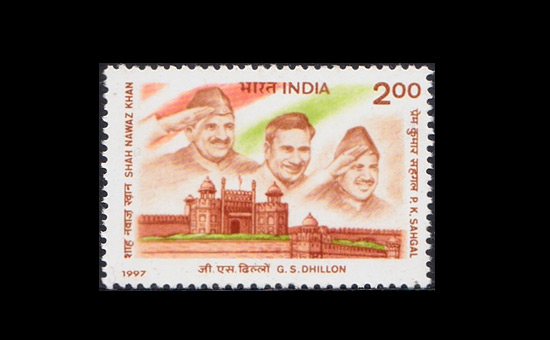 Postal of Shri Sehgal, Dhillion and Nawaz Khan.
Postal of Shri Sehgal, Dhillion and Nawaz Khan.
One such
historical event is the untold story of Red Fort Trials of Azad Hind Fauj
officials; specially the very first trial of Lt Colonel Prem Kumar Sehgal, Lt
Colonel Gurbaksh Singh Dhillon and Major General Shah Nawaz Khan.
The trials that began in November 1945 to execute prisoners of the defeated Azad Hind Fauj, had a huge impact on India’s freedom movement.
“Formation of the I.N.A. and its heroic struggle proved beyond doubt that the British could no longer rely upon Indian sepoys to maintain their hold in India. The universal sympathy expressed all over India for the I.N.A. officers, when they were tried for treason in the Red Fort at Delhi, gave a rude shock to the British. The British realized that they were sitting on the brink of a volcano which might erupt at any moment. This consideration played an important role in their final decision to quit India.” 1
pg. 693
Thus the role of the trials in awakening Indians, especially those who were in British Indian Armed Forces, is incredible. Tigmanshu Dhulia’s recent film “Raag Desh” presented the subject sincerely. Through a powerful screenplay and court room drama, it showed the values that the Azad Hind Fauj stood for.
I have
always wondered how the Britishers held India for ninety years after the First
War of Independence. The British learned three important lessons from the 1857 mutiny.
One, keep India’s political leadership divided on the basis of religion.
They had seen the effect of Hindu Muslim unity in 1857 when leaders like Nana Sahib – Bahadur Shah Jafar; Tatya Tope – Firoz Shah; Rani Lakshmi Bai – Hazarat Mahal joined hands.
The Indian
National Congress had enough Muslim representation. Even then, the Muslim
League whose aim was to exploit the Muslim sentiments for political gains, was
constantly supported by British to achieve political non-unification of India.
To achieve this political unity Subhash Chandra Bose had, as President of the Indian
National Congress and Forward Block, always tried hard to negotiate with
Muslim League and similar organizations.
Two, the British made it a point to
maintain cordial relations with the rulers of 562 Princely States by providing privileges.
These states remained loyal to the British even when they were on the verge of
defeat (not all India but in individual battles) in 1857. Britishers never
abolished their nominal and fragile authority in British Indian Empire.
In return, the Princely States never provoked any revolt against them in ninety years. Politically, states didn’t have any impact on the imperial government and militarily, they had nominal command over the small militia called Imperial Service troops which was loyal to Imperial government and was a subsidiary of British Indian Army or Royal Indian Army.
This
federal discrimination between Princely states and the rest of India was one of
the reasons, why many Indians did not want independence. The federal part of
Government of India Act 1935, which was designed to grant provincial autonomy
to Princely States, was strongly opposed by Netaji Subhas Chandra Bose.
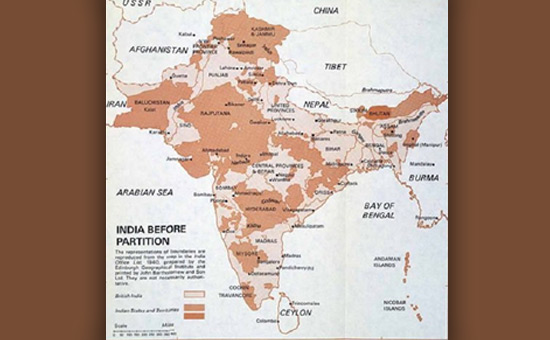 Princely States in orange. Courtesy John Bartholomew & Sons Ltd.
Princely States in orange. Courtesy John Bartholomew & Sons Ltd.
Three, post 1857 Britishers kept Indian
soldiers brainwashed. The Presidency Armies of Bengal, Bombay and Madras were
merged to form a regular British Indian Army. They kept the Indian forces away
from any political influence. It was like commandments noted in the Arc of Covenant, never to play with the
religious sentiments of Indian soldiers.
Regiments comprised of the soldiers of the same caste or religion with separate facility of accommodation, mess and kitchen based on community. The British propagated the puny concept of ‘Regimental Pride’ where soldier’s loyalty was attached to his regiment not the King Emperor.
There was
no place for feelings towards their country and people; regimental pride,
tradition and rank were everything they would live and strive for. Indian
troops were the invisible sword of the British Empire that could deal with and overcome
any revolution and civil disobedience within India or abroad. In fact it was on
the orders of the British that Indian troops fired on the peaceful gathering at
Jallianwala Bagh (1919) and Qissa Khwani Bazar (1930).
It is
surprising to know why 57 battalions of the British Indian Army remained
unaffected from the nation-wide wave of independence and significantly
contributed in suppressing Quit India Movement of 1942. That too at a time when
other battalions of British Indian Army were busy fighting World War 2. The
answer is thought provoking but beyond the scope of this article.
Indian
troops were betrayed by their masters during the world wars. They were even
deprived of evacuation from the lost battle fronts of Europe, North Africa and
South East Asia. Though not featured in the Christopher Nolan film Dunkirk but in 1940 one out of four
contingents of Indian troops was left alone at Dunkirk, France. They were later
captured by Germans because British gave priority to the evacuation of their
French allies, whose lives was more precious than their colonial slaves.
Indian
soldiers continued to remain loyal despite the huge discrimination between the
English and Indian soldiers of the same regiment. When Subhas Chandra Bose asked
Indian Prisoners of War, in German controlled Europe, to join Free Indian
Legion hardly three thousand volunteered for taking up arms against the
British.
Fortunately the situation was not the same in Southeast Asia. On his clarion call 40 -50 thousand Indian Prisoners of War volunteered for the Azad Hind Fauj. 25 lakh Indian civilians settled in Southeast Asia, mostly South Indians, responded to Bose’s call for an Armed Struggle.
At a
public meeting at Cathay Hall on 21/10/1943, Netaji read his famous
Proclamation setting up the Provisional Government of Free India at Singapore. The
government declared war against Britain and U.S.A. The Azad Hind Government was
recognized by nine nations including Germany, Japan, Italy, Thailand, Burma,
Manchukuo, Philippines and Ireland.
Netaji flew to Tokyo on 28/10/1943 where he attended the Great East Asia Conference. There Premier Tojo announced on 6/11/ that Japan had decided to hand over the Andaman and Nicobar Islands to the Provincial Government of Azad Hind.
 Postal Stamp, Azad Hind government 25th
Anniversary.
Postal Stamp, Azad Hind government 25th
Anniversary.
The Azad
Hind Government had a proper organized structure with ministries of Finance,
Defense & War, law, women organization, Broadcasting and publicity. It had
its bank, currency, hospitals, court, civil code and a national planning
commission as well. This organizational strength gave greater legitimacy to the
Indian armed struggle for Independence.
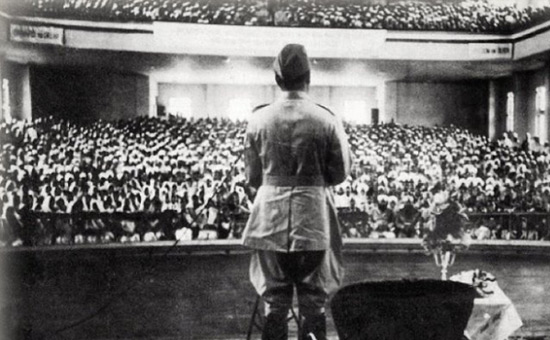 Netaji speaking at Cathay Theatre, Singapore. Pic courtesy National Archives Singapore.
Netaji speaking at Cathay Theatre, Singapore. Pic courtesy National Archives Singapore.
There was
no religious discrimination amongst the soldiers of Azad Hind Fauj. It did not
have a separate facility of kitchen and mess for Hindu & Muslim soldiers;
all were considered sons of the same soil.
All four
brigades (Gandhi Brigade, Azad Brigade, Nehru Brigade, and Subhas Brigade)
propagated National Pride rather than regimental pride. Its unique structure
comprised soldiers of different states and communities (Bengali, Marathi,
Tamil, Punjabi, Pathan) into a single unit, unlike the British Indian Army that
had separate regiments based on caste and creed.
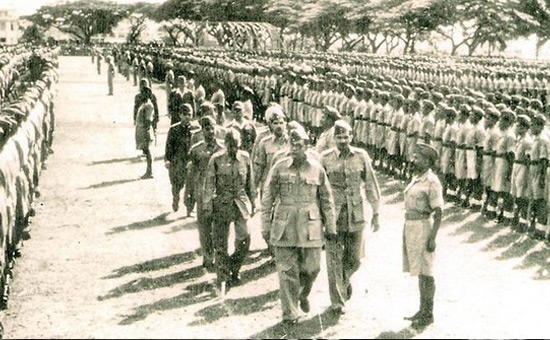 Netaji reviewing Azad Hind Fauj, Singapore. Courtesy Netaji Research Bureau, Kolkata.
Netaji reviewing Azad Hind Fauj, Singapore. Courtesy Netaji Research Bureau, Kolkata.
I.N.A. and Japanese soldiers marched towards Imphal and Kohima in India’s northeast. It started in March and was a campaign that did not meet with success. In April 1944, fighting alongside the Imperial Japanese Army, Azad Hind Fauj (AHF) secured the first Indian victory in the parts of Arakan - it is mountainous terrain shared between
Indian state of Manipur, Nagaland, Mizoram and Burma. Maximum area of Arakan is
in Burma/Myanmar.
16 Kms
from Imphal was fought The Battle of Red Chill between Japanese and British
soldiers. Today a memorial stands there today. To see pictures
Rangoon,
which was left in the hands of the I.N.A. after its evacuation by the Japanese
was occupied by the British early in May 1945. The I.N.A. men were disarmed and
made prisoners.
Allied
forces came out victorious in World War 2. The Azad Hind Fauj (AHF) lost the
battle ground in Burma Campaign. Many believe that Netaji died in a plane crash
of August 1945.
At the end
of the war approximately 16,000 soldiers of AHF were captured and sent back to
India. They were kept in prisons at Attock, Pune (Kirkee), Multan, Kolkata (Jhingergacha,
Nilganj), Delhi (Lal Quila, Bahadurgarh).
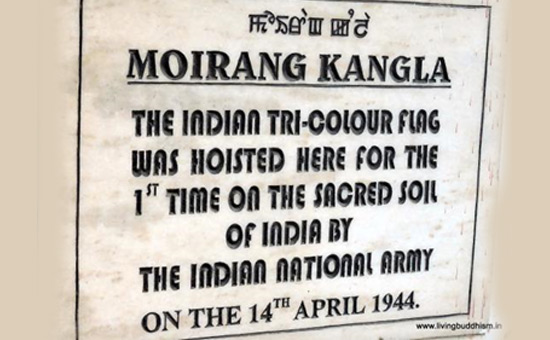 Sign of victory, Moirang-Manipur.
Sign of victory, Moirang-Manipur.
To see pictures
at I.N.A Museum Moirang, Manipur
Indians in
the hinterland were unaware of the activities of Netaji and AHF due to censorship
imposed by the British government. However, trials of the AHF at Red Fort undid
the censorship.
Three officers
of the AHF - P.K. Sehgal, G.S. Dhillon and Shah Nawaz Khan were charged with
murder and waging war against the King. The British government wanted to
execute AHF men by declaring them as murderers and traitors through public
trails.
This attempt
to diminish the national spirit backfired badly.
“The official evidence, given in the course of the trial, for the first time brought home to the Indians the magnitude of the I.N.A. organization and the heroic feats performed by it.” 1 pg. 723. It was only then that people realized that AHF was truly an Indian army dedicated to India’s freedom.
The trial galvanized India’s thirst for independence. The country wanted the immediate release of AHF men; they were national heroes now.
Countless
public gatherings and political meetings, in support of AHF, were held throughout
the country. Mass rallies and protests were organized by all political parties
including the Indian National Congress, Muslim League, Hindu Maha Sabha and
Akali Dal.
India
witnessed political unity for the first time in years due to protests for
release of AHF soldiers.
India’s best lawyers including Sir Tej Bahadur Sapru, Bhulabhai Desai, Dr. K. N. Katju, M. Asaf Ali, Jawaharlal Nehru were appointed, as INA Defense Committee, to fight the case at Red Fort.
Independent India does not have a day dedicated to INA or AHF. In the winter of 1945-46, however, every other day was celebrated as Azad Hind Fauj Divas or INA Day. Congress’s INA week (5 to 12 November 1945) recorded a gathering of seven lakh supporters of Azad Hind Fauj, in Deshapriya Park Calcutta.
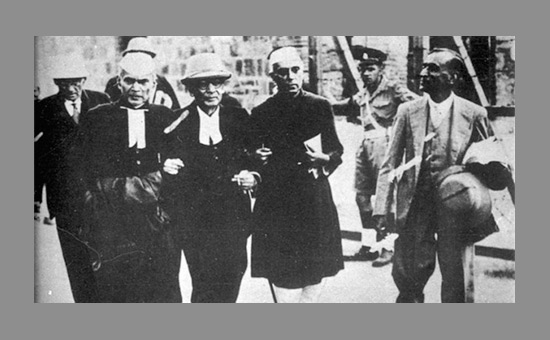 Members of INA Defence Committee, Red Fort Delhi. Pic courtesy @INC/twitter.
Members of INA Defence Committee, Red Fort Delhi. Pic courtesy @INC/twitter.
It was a very
strong conviction of Netaji Subhas Chandra Bose that an armed rebellion by
Indian soldiers of Royal Indian Army, Royal Indian Navy and Royal Indian Air Force
would shake the foundation of British Empire in India. This time armed forces
were not untouched with the upheaval in India.
As the
story of Azad Hind Fauj unfolded, view of the British Indian forces on AHF and their
own role during the war changed. They got stirred with a new political
consciousness and begin to think in terms of independence.
British
propaganda of praising the Indian troops for defending Indian soil against INA
and Japan failed. Indian Soldiers soon realized their wrong stand and learnt
that the sacrifice of their brothers would go in vain if they did not revolt
against the British this time.
Pro-AHF
sympathies within the British Indian forces increased the disquiet. It lead to a
series of revolts and mutinies in navy, air force and army in early 1946.
Due to immense
public and political pressure, the first Red fort trials concluded with the
release of all the three accused. They were just expelled from the Royal Indian
Army which they were not part of anyway. The trio received a grand public
reception at Lahore where they shared water from the same jug symbolizing unity.
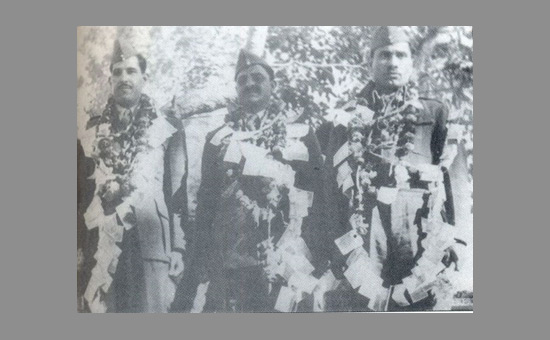 Reception of Sehgal, Dhillion & Shah Nawaz at Lahore. Pic courtesy Defence Forum of India.
Reception of Sehgal, Dhillion & Shah Nawaz at Lahore. Pic courtesy Defence Forum of India.
Many AHF
soldiers and officers were still in prison camps and ready to face similar
trials.
“Revolt of a sections serving in the Royal Indian Navy followed by grave disturbances in Bombay. The Army and Air Force were not altogether unaffected. There was trouble in several places, though not of a serious character. The navy revolt started on 18 February.” 1 pg 727
Royal Indian
Army and Royal Indian Air Force supported the mutiny in a fantastic way. At its
height, 78 naval ships and 27 shore establishments and 20,000 sailors took part
in the mutiny. Troops of Gurkha and Baluch regiments in Karachi refused to fire
on Royal Indian Navy mutineers. 1200 Airmen of Royal Indian Air Force went on
procession in their support on 20 February. Indian officers and pilots of RIAF
refused to pilot planes to bomb the ships. Transport units of RIAF and RIA
refused to carry British troops to fight the naval Ratings of RIN.
For
British authorities, it was impossible to end this revolt without a political
intervention of Indian National Congress and Muslim league. On February 23 Sardar
Vallabh Bhai Patel met the strike committee leaders to assure and requested
them to end the revolt. Muslim League also made similar calls.
Just a
week after RIN mutiny, 1700 men of Signal corps of RIA stationed at Jabalpur
revolted against their British superiors. To suppress the uprising British sent
in a bayonet charge that killed 80 and injured 30. The situation was that
politically and militarily British could not hold India any more. Loyalty of
Indian troops as a whole was now in doubt.
It was
because of these developments that the Cabinet Mission was sent from London,
within weeks of the navy revolt, which reached on 24 March 1946. This was well
received throughout India, it was felt that the grant of independence to India
was now a certainty.
If mutinies of the Indian armed forces were the last nail in the coffin of British Empire, then Azad Hind Fauj acted like a hammer and Netaji himself was the striker. If Neil Arm Strong were an Indian he would have said, “One small step by Netaji, but one giant leap for Indians”.
So
did the I.N.A. contribute to the British decision to leave India? Yes. A surge in public sentiment
during and after the Red Fort Trials motivated the navy to revolt which made the
British realize that they could no longer hold on India. This communication
confirms that.
Chief Justice P.B. Chakrabarty of Calcutta High Court, who had also served as the acting Governor of West Bengal in India, disclosed the following in a letter addressed to the publisher of Dr. R.C. Majumdar's book ‘A History of Bengal’.
The CJ wrote: “My direct question to him was that since Gandhi's "Quit India" movement had tapered off quite some time ago and in 1947 no such new compelling situation had arisen that would necessitate a hasty British departure, why did they have to leave? In his reply Atlee cited several reasons, the principal among them being the erosion of loyalty to the British Crown among the Indian army and navy personnel as a result of the military activities of Netaji. Toward the end of our discussion I asked Atlee what was the extent of Gandhi's influence upon the British decision to quit India. Hearing this question, Atlee's lips became twisted in a sarcastic smile as he slowly chewed out the word, "m-i-n-i-m-a-l!” ((Subhas Chandra Bose, the
Indian National Army, and the War of India's Liberation-Ranjan Borra, Journal of Historical Review, no. 3, 4 (Winter 1982)).
It is the people of India who collectively contributed to India’s freedom.
References
1. History and Culture of the Indian
People published by the Bharatiya Vidya Bhawan.
2. The Ocean of Churn by Sanjeev Sanyal.
3. His Majesty’s opponent by Sugatha Bose.
4. Chalo
Delhi by Netaji Research Bureau.
Also read
1 Did
Ahimsa get Indian freedom?